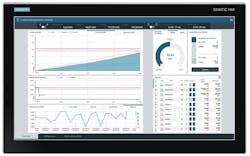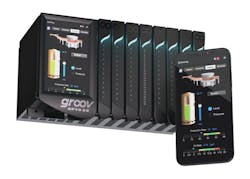Two major attractions of automation technologies are their ability to deliver equipment downtime minimization and improve overall equipment effectiveness (OEE). Now, with electricity costs on the rise and regulatory requirements increasingly more intense, manufacturers are applying automation to their energy optimization problems.
The global energy market hit a crisis point in 2022, fueled by fallout from the COVID pandemic and supply chain disruptions, both of which were compounded by geopolitical events like the Russian invasion of Ukraine. Electricity price spikes were particularly acute in Europe, but U.S. manufacturers have also experienced substantial rate hikes over the last few years. Wholesale electricity prices for 2024 seemed to have stabilized and even dropped in some cases, according to the U.S. Energy Information Administration. However, periods of high demand and power market supply constraints could lead to additional temporary spikes in prices.
The volatility of electricity pricing and ongoing pressure on manufacturers to reduce expenses has sparked interest in energy optimization. Emerging technologies like intelligent sensors, enhanced connectivity, advanced analytics, the cloud and ultimately, AI are putting solutions within reach. Manufacturers see opportunity to bring technologies and process change to bear on energy efficiency challenges and goals in much the same manner they channeled budget and resources to automation solutions aimed at reducing downtime and boosting OEE.
“There’s a lot of development going into renewable sources, but at the same time, manufacturers want to reduce their overall energy footprint and get away from high prices,” said Travis Cox, chief technology evangelist for Inductive Automation. “They’re looking to optimize processes to do that, which isn’t something they thought about before. In the past, they looked at processes and equipment according to how much product they were producing or how downtime affects the bottom line. Companies have solved those problems with processes and sensors in place and now they want to start considering energy in that same way.”
Internal application results in turn-key system
There are several use cases for applying automation in energy monitoring and optimization applications that are starting to gain traction. Many early initiatives in this area focused on reducing CO2 emissions and guiding a transition to more sustainable power sources. This has evolved into current activities focused on using automation hardware, software and cloud platforms to mitigate energy waste resulting from idle machinery, sub-optimally configured control systems and foster insights to redirect power usage away from peak electricity cost periods.
Jan Edler, IIoT (Industrial Internet of Things) manufacturing applications leader at Emerson, sees increasing demand for technologies to address programmatic leakages associated with pneumatic equipment, to identify and redirect idle machinery and help manufacturers achieve net zero goals. “When you have a facility with 40 CNC machines not running or running empty at shift change, it’s a huge baseload having them all connected in idle mode,” Edler explains. “If machine builders can shut down energy usage that’s not needed, there’s huge savings potential.”
Emerson set out to address the energy efficiency challenge in its own Sissach, Switzerland plant, which produces pressing products and accessories like battery hydraulic tools and associated jaws and rings. While production in the 45,000 sq.-ft. facility was highly automated, there was little information about air consumption needs. When a plant expansion was planned, it was assumed a new air compressor would be required. Deploying Emerson Aventics AF2 Series flow sensors to 20 of the most significant compressed air usage sites, the operations team was able to monitor a range of process parameters such as pressure, temperature and volumetric flow rates for about 70% of compressed air usage. That data was securely sent via MQTT connectivity protocols to a preconfigured cloud service, which provides an array of visualization capabilities and dashboards for analyzing compressed air use.
The Sissach team was able to identify equipment using more air than similar assets and make adjustments, including correcting a series of leakages and other anomalies that mitigated the need to add an additional compressor. In total, the team identified 850 liters per minute of air lost as leaks. When fixed, the elimination of these leaks saved the plant $58,000 in electricity costs on top of 68,000 kg of CO2 emissions over the next 10 years.
In addition to the AF2 smart sensors used, other technologies deployed at the Sissach facility included the pre-designed edge-enabled cabinet and compressed air management monitoring and analytics application—all of which will soon available from Emerson to help plants visualize and benchmark compressed air and gas consumption trends, costs and CO2 emissions, Edler said.
Energy analytics
Even though energy monitoring and optimization are now more squarely on manufacturers’ radar screens, there are concerns that making the shift is too difficult. Aveva has taken this concern to heart with its cloud-based Aveva Advanced Analytics offering, which touts a no-code approach, bolstered by artificial intelligence (AI), to enable enterprises to monitor and predict a range of quality, throughput and energy efficiency metrics. This software-as-a-service product can help identify patterns and conditions to optimize energy usage, suggest corrective actions for any deviations from normal conditions and flag unnecessary energy consumption of idle assets.
“It’s been easy enough to collect energy consumption information—whether it’s water, air, gas, electricity or steam, but historically it may not have been as critical as the rest of the process information gathered with SCADA,” said Doug Warren, senior vice president of the HMI and SCADA business at Aveva. “The challenge then becomes what to do with it, especially if you have multiple lines and multiple plants in multiple countries.”
To achieve effective energy efficiency insights, manufacturers have to meld that data with other variables such as utility provider information, rate plan and peak hour pricing. These data sources exist in silos within the organization, many tucked away in historians with their own ways of categorizing and contextualizing data that can make it difficult to visualize or share with other systems, Warren explained. “Just having energy consumption information isn’t the whole answer, because if it’s not in the context of production it doesn’t have a lot of meaning,” he said. “Moreover, manufacturers often don’t have the people to keeping that data flowing, populating those dashboards and analyzing the outcomes.”
Aveva’s Connect is a hybrid industrial intelligence platform designed to address this siloed data problem by providing an open, single source for advanced visualization and analysis of industrial data. Unlike generic cloud platforms, Connect maintains the context for industrial data—which means it knows, for example, that an energy meter associated with a particular line or machine is part of a specific production unit at a plant. Connect also takes care of data cleansing and transformation so that data scientists are not required to add informational context, which greatly reduces the manual effort associated with energy monitoring and management, Warren said.
“Manufacturers may have looked at this problem years ago and put it into the ‘too hard bucket’ and moved on,” he added. “With these cloud-based analytics tools, you don’t need a room full of people with spreadsheets working on the problem anymore.” In the future, Warren sees a more automated scenario where predictive insights automatically trigger a corrective action to address an energy-related recommendation; however, he doesn’t think industry is there yet.
Beginning the process
Siemens is helping manufacturers get started on the energy efficiency path with an array of technologies, from smart meters that plug into PLCs on the factory floor to software suites designed to bring energy transparency to automation systems. The Simatic Energy Suite and S7 Energy Efficiency Monitor can measure individual loads as well as the efficiency of entire machines. The suite is integrated with HMIs, allowing operators on the shop floor to see if a machine is operating outside the bounds of normal energy use and identify any inefficient operating behaviors, which aids in faster problem resolution, according to Alan Cone, manager of product marketing for HMI at Siemens.
These same data points can automatically be sent to Simatic Energy Manager Pro, which manages energy consumption across site boundaries from Simatic Energy Suite and other measuring devices. Integrating Simatic Energy Manager Pro and Simatic Energy Suite lets manufacturers perform companywide energy analyses, including plant comparisons, optimization of energy purchases and compliance with regulations.
Not surprisingly, digital twins and AI technologies are expected to play a significant role in bringing greater intelligence and automation to energy monitoring and management, yet Cone said this process is still in its early days. “There’s a lot of opportunity for AI to help analyze data and enable smart, quick decisions on data, but now we’re dependent on humans to look at the data and make correlations,” he said.
The state of Indiana has determined that energy monitoring is a good starting point for small- and mid-sized manufacturers to experiment with smart manufacturing and Industry 4.0 use cases. Sponsored by a state grant, the Energy Insights program is offering an integrated starter kit aimed at helping manufacturers track energy use to pinpoint potential savings. The kit features sensors and remote I/O modules to monitor electric loads. Specific technologies included in the kit are Opto 22’s Groov EPIC edge programmable industrial controller and Inductive Automation’s Ignition software, available on the cloud or on-premises, for visualizing and analyzing the energy data. There is also a systems integration and education component to the program, notes Becca Gillespie, managing director for Energy Insights at Energy Systems Network.
Industry experts advise starting with small, targeted initiatives as the best way to get results and scale energy monitoring practices to achieve maximum enterprise impact. “Don’t try to tackle the whole plant—tackle a line and then factor in what you learned in that plant out to the rest of the enterprise,” said Siemens’ Cone. “Even little steps take you far down the path to sustainability and less energy usage.”
Leaders relevant to this article:






